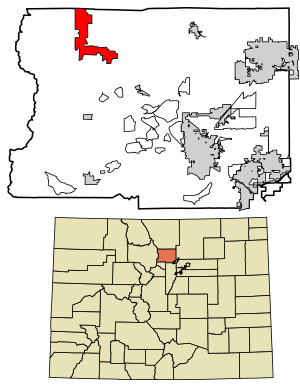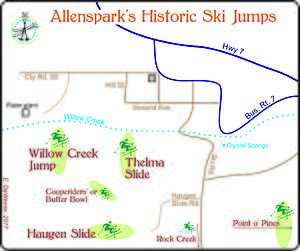Allenspark, Colorado facts for kids
Quick facts for kids
Allenspark, Colorado
|
|
|---|---|

Looking west toward Allenspark, Wild Basin and Mount Meeker in the background, Turkey Rock front left. DeWeese photo, 2014.
|
|

Location of the Allenspark CDP in Boulder County, Colorado
|
|
| Country | |
| State | |
| County | Boulder County |
| Government | |
| • Type | unincorporated town |
| Area | |
| • Total | 30.924 km2 (11.940 sq mi) |
| • Land | 30.891 km2 (11.927 sq mi) |
| • Water | 0.033 km2 (0.013 sq mi) |
| Elevation | 2,569 m (8,429 ft) |
| Population
(2020)
|
|
| • Total | 568 |
| • Density | 18.368/km2 (47.57/sq mi) |
| Time zone | UTC-7 (MST) |
| • Summer (DST) | UTC-6 (MDT) |
| ZIP Code |
80510
|
| Area codes | 303 & 720 |
| Highways | |
| GNIS feature ID | 2407720 |
Allenspark is a small community in Boulder County, Colorado, United States. It's not a formal town with its own government. Instead, it's an "unincorporated area" and a "census-designated place" (CDP). This means the government counts its population. Allenspark is part of the larger Boulder, CO Metropolitan Statistical Area. In 2020, about 568 people lived there. The local post office uses the ZIP code 80510.
Contents
Allenspark: A Mountain Community
Allenspark is a special place. It's a high meadow surrounded by tall mountains. Native Americans first visited this area. Later, trappers came through. The name "Allenspark" comes from a miner who built the first cabin here.
Early Settlers and Gold Rush
During the Colorado Gold Rush in 1859, a man named Alonzo Nelson Allen came to Colorado. He was looking for gold. Allen settled near the St. Vrain River. He also explored and raised cattle in the Allenspark area. In 1864, he built a cabin there. Sadly, his cabin burned down in 1894, the same year he passed away.
The main village of Allenspark is on land that once belonged to George Mack. This spot had a great water source called Crystal Springs. In 1896, Mack sold some of his land. A company then created a plan for the village. They started selling small building plots.
Some people say Alonzo Allen didn't officially own the land. He just lived there. George Pheifer, an early settler, said Allen's only contribution was giving the area its name.
From Mining to Tourism
In the late 1890s, most people in Allenspark were farmers or ranchers. But in the early 1900s, people got excited about gold again. A mining company tried to find gold, but it didn't work out.
Meanwhile, tourism started to grow. Farmers and miners found they could earn more money by helping tourists in the summer. The first post office opened in 1896.
The village of Allenspark grew as summer visitors bought land. They built cabins between 1900 and 1920. Many people came from nearby Longmont. Others traveled from states like Kansas and Oklahoma.
The larger Allenspark area includes smaller communities. These are Ferncliff, Longs Peak, Meeker Park, Peaceful Valley, Raymond, and Riverside. This whole area is protected by the Allenspark Fire Protection District.
Allenspark used to be mostly a summer vacation spot. But now, better roads and technology make it easier to live there all year. Many people call Allenspark home even in winter. In 2010, there were 892 housing units. About 267 were lived in year-round, and 577 were used seasonally.
Some businesses in Allenspark are still only open in the summer. You can find restaurants, lodges, and gift shops. There's a gas station and grocery store in Ferncliff. However, cell phone service is very limited.
Skiing History
Skiing was very popular in Allenspark in the 1920s and 1930s. International ski jumping contests were even held here! There were several ski jumps and courses, like the Willow Creek Slide and the Butter Bowl. The Rock Creek Ski area opened after World War II. It operated until 1952. Today, cross-country skiing is still a favorite activity. People especially enjoy it on Rock Creek and in Wild Basin.
Allenspark's Location
Allenspark is in the northwest part of Boulder County. It's located within Roosevelt National Forest. This area is part of the Front Range of the Colorado Rockies. The western edge of Allenspark touches Rocky Mountain National Park.
State Highway 7 goes through the community. This highway leads north about 15 miles (24 km) to Estes Park. It also goes east about 19 miles (31 km) to Lyons.
The Allenspark CDP covers an area of about 7,641 acres (30.924 km2). A small part of this, about 8.2 acres (0.033 km2), is water.
Allenspark Weather
| Climate data for Allenspark 3NW, Colorado, 1991–2020 normals: 8500ft (2591m) | |||||||||||||
|---|---|---|---|---|---|---|---|---|---|---|---|---|---|
| Month | Jan | Feb | Mar | Apr | May | Jun | Jul | Aug | Sep | Oct | Nov | Dec | Year |
| Record high °F (°C) | 59 (15) |
55 (13) |
65 (18) |
70 (21) |
82 (28) |
85 (29) |
90 (32) |
87 (31) |
83 (28) |
74 (23) |
67 (19) |
55 (13) |
90 (32) |
| Mean maximum °F (°C) | 50.9 (10.5) |
50.4 (10.2) |
57.2 (14.0) |
63.0 (17.2) |
74.2 (23.4) |
80.2 (26.8) |
86.1 (30.1) |
83.1 (28.4) |
78.3 (25.7) |
68.4 (20.2) |
57.5 (14.2) |
50.2 (10.1) |
86.3 (30.2) |
| Mean daily maximum °F (°C) | 32.2 (0.1) |
34.5 (1.4) |
41.7 (5.4) |
46.1 (7.8) |
56.0 (13.3) |
68.6 (20.3) |
74.3 (23.5) |
72.7 (22.6) |
65.7 (18.7) |
52.4 (11.3) |
40.6 (4.8) |
33.4 (0.8) |
51.5 (10.8) |
| Daily mean °F (°C) | 23.2 (−4.9) |
24.6 (−4.1) |
31.0 (−0.6) |
34.4 (1.3) |
44.1 (6.7) |
53.3 (11.8) |
59.3 (15.2) |
57.7 (14.3) |
51.1 (10.6) |
40.6 (4.8) |
30.5 (−0.8) |
23.8 (−4.6) |
39.5 (4.1) |
| Mean daily minimum °F (°C) | 14.1 (−9.9) |
14.7 (−9.6) |
20.3 (−6.5) |
22.8 (−5.1) |
32.2 (0.1) |
38.1 (3.4) |
44.3 (6.8) |
42.7 (5.9) |
36.5 (2.5) |
28.7 (−1.8) |
20.3 (−6.5) |
14.1 (−9.9) |
27.4 (−2.6) |
| Mean minimum °F (°C) | −7.1 (−21.7) |
−8.5 (−22.5) |
−1.7 (−18.7) |
6.4 (−14.2) |
20.0 (−6.7) |
28.4 (−2.0) |
36.0 (2.2) |
35.2 (1.8) |
20.0 (−6.7) |
12.1 (−11.1) |
−0.6 (−18.1) |
−3.5 (−19.7) |
−15.5 (−26.4) |
| Record low °F (°C) | −21 (−29) |
−23 (−31) |
−23 (−31) |
−8 (−22) |
10 (−12) |
23 (−5) |
31 (−1) |
31 (−1) |
11 (−12) |
3 (−16) |
−15 (−26) |
−17 (−27) |
−23 (−31) |
| Average precipitation inches (mm) | 1.44 (37) |
1.38 (35) |
3.11 (79) |
3.61 (92) |
3.06 (78) |
1.83 (46) |
2.41 (61) |
2.69 (68) |
2.21 (56) |
1.14 (29) |
1.44 (37) |
0.84 (21) |
25.16 (639) |
| Average snowfall inches (cm) | 20.8 (53) |
18.2 (46) |
34.0 (86) |
36.9 (94) |
12.0 (30) |
1.8 (4.6) |
trace | 0.0 (0.0) |
7.3 (19) |
9.2 (23) |
18.8 (48) |
12.7 (32) |
171.7 (435.6) |
| Source 1: NOAA | |||||||||||||
| Source 2: XMACIS (1991-2003 snowfall, records & monthly max/mins) | |||||||||||||
Allenspark Population
The United States Census Bureau first counted Allenspark as a CDP for the 2000 United States Census.
| Allenspark CDP, Colorado | ||
|---|---|---|
| Year | Pop. | ±% |
| 2000 | 496 | — |
| 2010 | 528 | +6.5% |
| 2020 | 568 | +7.6% |
| Source: United States Census Bureau | ||
See also
 In Spanish: Allenspark para niños
In Spanish: Allenspark para niños




